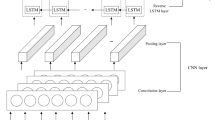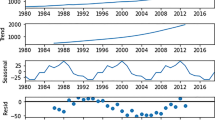Abstract
The accuracy of short-term load forecasting plays an important role in the operation of the power system. However, because of the randomness of load data, it is a difficult task to provide accurate load forecasting. In this work, a short-term load forecasting approach integrating empirical mode decomposition (EMD), bidirectional long short-term memory (BiLSTM) and attention mechanism is proposed. At first, the electric load series are decomposed into several intrinsic mode functions (IMFs) by EMD. Then a BiLSTM neural network based on attention mechanism is applied on each of the extracted IMFs to predict the tendencies of these IMFs. At last, the prediction results of all IMFs are combined to get the final prediction result of electric load. The proposed approach is evaluated on a real-world dataset from Australian Energy Market Operator. The experimental results demonstrates that the prediction accuracy of the proposed approach can be greatly improved, compared with the other 7 benchmark models. The experiments also showed that the recommended number of IMFs are either 3 or 4 based on both prediction accuracy and running time.





Similar content being viewed by others
Referencess
Hernandez L et al (2014) A survey on electric power demand forecasting: future trends in smart grids, microgrids and smart buildings. IEEE Commun Surv Tutor 16(3):1460–1495
Raza MQ, Khosravi A (2015) A review on artificial intelligence based load demand forecasting techniques for smart grid and buildings. Renew Sustain Energy Rev 50:1352–1372
Hong T, Fan S (2016) Probabilistic electric load forecasting: a tutorial review. Int J Forecast 32(3):914–938
Liu N, Babushkin V, Afshari A (2014) Short-term forecasting of temperature driven electricity load using time series and neural network model. J Clean Energy Technol 2(4):327–331
Bercu S, Proïa F (2013) A SARIMAX coupled modelling applied to individual load curves intraday forecasting. J Appl Stat 40(6):1333–1348
Moon J, Kim Y, Son M, Hwang E (2018) Hybrid short-term load forecasting scheme using random forest and multilayer perceptron. Energies 11(12):3283
Wang X, Yaqi W (2016) A hybrid model of EMD and PSO-SVR for short-term load forecasting in residential quarters. Math Probl Eng,2016,(2016–12–26) 2016(2016):1–10.
Yu Y et al (2019) Forecasting a short-term wind speed using a deep belief network combined with a local predictor. IEEJ Trans Electr Electron Eng 14(2):238–244
Samuel IA et al (2019) Artificial neural network base short-term electricity load forecasting: a case study of a 132/33 kv transmission sub-station. Int J Energy Econ Policy 10(2):200–205
Sun G et al (2020) Short-term building load forecast based on a data-mining feature selection and LSTM-RNN method. IEEJ Trans Electr Electron Eng 15(7):1002–1010
Bedi J, Toshniwal D (2020) Energy load time-series forecast using decomposition and autoencoder integrated memory network. Appl Soft Comput 93:106390
Li H et al (2020) Ultra-short-term load demand forecast model framework based on deep learning. Energies 13(18):4900
Bahdanau D, Cho K, Bengio Y (2014) Neural machine translation by jointly learning to align and translate. arXiv:1409.0473.
Luong T, Pham H, Manning CD (2015) Effective approaches to attention-based neural machine translation. In: Proceedings of the 2015 conference on empirical methods in natural language processing. Association for Computational Linguistics, Lisbon, Portugal, pp 1412–1421. https://doi.org/10.18653/v1/D15-1166
Choi H, Cho K, Bengio Y (2018) Fine-grained attention mechanism for neural machine translation. Neurocomputing 284:171–176
Lin J, Shao Y, Djenouri Y, Yun U (2021) ASRNN: a recurrent neural network with an attention model for sequence labelling. Knowl-Based Syst 212:106548
Qin CX, Qu D (2020) Towards understanding attention-based speech recognition models. IEEE Access 99:1–1
Cun X, Pun CM (2020) Improving the harmony of the composite image by spatial-separated attention module. IEEE Trans Image Process 99:1–1
Ali SM, Farid G (2019) Image processing based optical flow estimation using dilated convolution & channel attention methodologies. J Flow Vis Image Process 26(4)
Mandal BN, Chakrabarti A (2003) A generalization to the hybrid Fourier transform and its application. Appl Math Lett 16(5):703–708
Benedetto JJ, Frazier MW, Torrésani B (1994) Wavelets: mathematics and applications. Phys Today 47(11):90–91
Huang NE et al (1998) The empirical mode decomposition and the Hilbert spectrum for nonlinear and non-stationary time series analysis. Proc A 454(1971):903–995
Qiu X et al (2017) Empirical mode decomposition based ensemble deep learning for load demand time series forecasting. Appl Soft Comput 54:246–255
Fan GF et al (2016) Electric load forecasting by the SVR model with differential empirical mode decomposition and auto regression. Neurocomputing 173:958–970
Ghelardoni L et al (2013) Energy load forecasting using empirical mode decomposition and support vector regression. IEEE Trans Smart Grid 4(1):549–556
Australian Energy Market Operator (AEMO). Available online: www.aemo.com.au. Accessed Aug 2021
Author information
Authors and Affiliations
Corresponding author
Additional information
Publisher's Note
Springer Nature remains neutral with regard to jurisdictional claims in published maps and institutional affiliations.
Rights and permissions
About this article
Cite this article
Meng, Z., Xie, Y. & Sun, J. Short-term load forecasting using neural attention model based on EMD. Electr Eng 104, 1857–1866 (2022). https://doi.org/10.1007/s00202-021-01420-4
Received:
Accepted:
Published:
Issue Date:
DOI: https://doi.org/10.1007/s00202-021-01420-4




